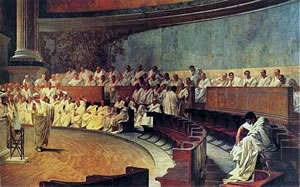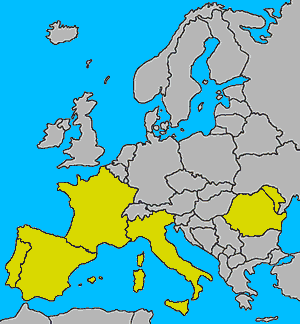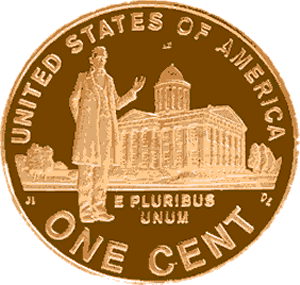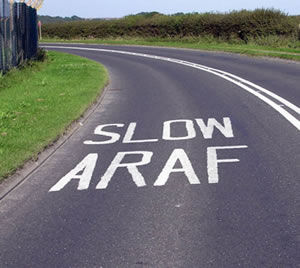Latin was the language of the Roman Empire. First spoken only in and near the city of Rome, Latin became the official language of business and government as the Roman Empire spread to most of Europe. Few people speak Latin as their primary language today, though Latin survives in several Romance languages.
Classical Latin was the language of literature and was spoken in the Senate; the common people and Roman soldiers spoke a variant of the language known as Vulgar Latin.

Roman_Senate
Roman senators, and poets spoke Classical Latin, but most common people spoke a variant of the language called Vulgar Latin.
Vernacular languages or dialects are spoken by the ordinary people of a region or country. These local languages blended with Vulgar Latin to form what we now call Romance languages. Romance refers to the fact that the languages originated in Rome. Today there are approximately twenty-five commonly spoken Romance languages. They include Italian, Spanish, Portuguese, French, and Romanian.
The power of the Roman Empire faded at about the same time Christianity spread through Europe. Roman provinces began to assert their authority beginning in the fifth century of the Common Era, but Latin remained the language of the church for centuries. Today, Latin is the language of the Roman Catholic Church and the official language of the Vatican city-state. Many students worldwide continue to study Latin as Latin vocabulary is still widely used in law, medicine, and philosophy. E pluribus unum (“out of many, one”) is a Latin phrase found on most American currency.

Romance_Language_Map
Romance Languages are spoken primarily in Portugal, Spain, France, Italy and Romania.

E pluribus unum was considered a de facto motto of the United States until 1956 when the United States Congress adopted “In God We Trust” as the official motto.
Along with the Romance languages, most Europeans speak Slavic or Germanic languages. Slavic languages are spoken primarily in Eastern Europe, particularly in Poland, Russia, Croatia, Slovenia, Bulgaria, Macedonia, Bosnia and Serbia.
Germanic languages are spoken primarily in northern Europe, including the Netherlands, Sweden, Denmark, Germany, and the United Kingdom.
Modern English evolved from Germanic-speaking tribes who settled in Great Britain in the tenth and eleventh centuries. Scholars believe that English as spoken in 1000ce would sound like the Frisian languages spoken in the Netherlands and Denmark today. The Germanic speakers displaced Latin and many Celtic languages that were spoken at that time in Great Britain.
About 400,000 people in Wales speak Welsh, one of the few Celtic languages that is neither extinct nor classified as “endangered” by UNESCO. Celtic languages were prominent before the expansion of the Roman Empire. Despite the scarcity of speakers, the influence of the Celtic people lives on in stories and myths. Leprechauns, Halloween and the Blarney Stone are remnants of Celtic culture. Irish students are often encouraged to study traditional Celtic languages, but most Irish people speak English in everyday conversation.

A road sign in Wales written in English and in Welch.
Resources
Download this lesson as Microsoft Word file or as an Adobe Acrobat file.
View a Powerpoint presentation of this lesson.
Listen as Mr. Dowling reads this lesson.
Lexile Measure 1160L
Mean Sentence Length 16.31
Mean Log Word Frequency 3.21
Word Count 424
Mr. Donn has an excellent website that includes a section on Ancient Rome.
.
The Primary Romance Languages
Spanish/Castillian – 475 million speakers primarily in Spain, and Hispanic America.
Portuguese – 230 million speakers primarily in Brazil and Portugal.
French – 85 million speakers primarily in France, Canada, Belgium, western Switzerland, and Monaco.
Italian – 65 million speakers primarily in Italy and Switzerland.
Romanian – 24 million speakers primarily in Romania and Moldova.
Kreyol – 12 million speakers primarily in Haiti.
Catalan – 4.1 million speakers primarily in northeastern Spain and Andorra.
Venetian – 3.9 million speakers primarily in northeastern Italy.
Galician – 2.4 million speakers primarily in northwestern Spain.
Antillean Creole – 1.2 million speakers primarily in the Caribbean region,
Sardinian – 1 million speakers primarily in Sardinia.
Walloon – 300,000 speakers primarily in Belgium and France.
Occitan – 200,000 speakers primarily in Spain, France, and Italy.




